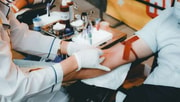Avoid This Shower Blunder That Left a Mum with Potential Vision Loss - The Painful Truth Revealed!
- Replies 4
As we age, our eyesight becomes one of our most cherished senses, and the thought of losing it can be terrifying. That's why a cautionary tale from a young mother's harrowing experience serves as a stark reminder to all of us, especially those who wear contact lenses.
Rachel Prochnow, a woman who was 34 weeks pregnant at the time, faced a nightmare scenario that began with a seemingly innocuous act—taking a shower with her contact lenses in. What followed was a harrowing ordeal of 'excruciating pain' and the grim prospect of permanent vision loss in one eye.
Prochnow initially dismissed the discomfort in her eye as a minor irritation, perhaps a torn lens from her workout at the gym. But the situation escalated quickly. By the next day, she was suffering from intense pain and extreme sensitivity to light, prompting an urgent visit to the optometrist. There, she received a diagnosis that would change her life: Acanthamoeba keratitis (AK).

AK is an infection caused by a parasite found in nearly all water sources, including tap, sea, and chlorinated water, as well as in soil. These parasites can enter the eye through tiny scratches on the surface and wreak havoc, leading to severe health complications.
'The pain that comes with AK makes giving birth look like a walk in the freaking park,' Prochnow shared on Instagram, emphasizing the severity of her suffering. For three months, she endured a regimen of around-the-clock eye drops, each needing to be administered five minutes apart, and the most rest she could muster was a mere 30 minutes at a time.
The infection's timing couldn't have been worse. Prochnow's pregnancy had to be induced three weeks early, and her treatment included a 'cancer drug' and biweekly blood tests to monitor her kidney function, as AK can also pose a risk of kidney failure.
What's particularly alarming is that Prochnow, like many contact lens wearers, was unaware of the risks associated with exposing her lenses to water. 'I had been wearing contacts since I was 12 and was never told not to swim, shower, or hot tub in them,' she lamented. Now, she faces the possibility of a cornea transplant and an uncertain visual future.
This infection, while rare, is a serious concern. Australian optometrists, such as Audrey Molloy from Optometry NSW, encounter only one or two cases in their entire careers. AK invades eye tissue aggressively, and despite the availability of disinfectants as treatment, the parasite's robust nature means it can withstand extreme conditions, including freezing and boiling temperatures, and even some disinfectants.
Molloy's insights highlight a critical point: 'Contact lenses and water do not go together.' This is one of the reasons behind the push for daily, disposable contact lenses, which minimize the risk of water contact.
For our readers, particularly those over 60 who may have been wearing contact lenses for decades, this story is a wake-up call. It's essential to follow best practices for lens care, which include not exposing them to water. This means removing lenses before showering, swimming, or using a hot tub.
If you've been neglecting these precautions, it's time to reconsider your habits to protect your precious eyesight. And if you know someone who wears contacts, share this story with them—it could save their sight.
 We invite you to share your experiences and tips for maintaining eye health in the comments below. Have you ever had a close call with your contact lenses? How do you ensure your eyes stay safe and healthy? Let's learn from each other and keep our vision clear for all the beautiful moments life has to offer.
We invite you to share your experiences and tips for maintaining eye health in the comments below. Have you ever had a close call with your contact lenses? How do you ensure your eyes stay safe and healthy? Let's learn from each other and keep our vision clear for all the beautiful moments life has to offer.
Rachel Prochnow, a woman who was 34 weeks pregnant at the time, faced a nightmare scenario that began with a seemingly innocuous act—taking a shower with her contact lenses in. What followed was a harrowing ordeal of 'excruciating pain' and the grim prospect of permanent vision loss in one eye.
Prochnow initially dismissed the discomfort in her eye as a minor irritation, perhaps a torn lens from her workout at the gym. But the situation escalated quickly. By the next day, she was suffering from intense pain and extreme sensitivity to light, prompting an urgent visit to the optometrist. There, she received a diagnosis that would change her life: Acanthamoeba keratitis (AK).

Rachel Prochnow suffered severe pain and faced the risk of vision loss after showering while wearing contact lenses, diagnosed with Acanthamoeba keratitis (AK). Credit: Instagram / Rachel Prochnow
AK is an infection caused by a parasite found in nearly all water sources, including tap, sea, and chlorinated water, as well as in soil. These parasites can enter the eye through tiny scratches on the surface and wreak havoc, leading to severe health complications.
'The pain that comes with AK makes giving birth look like a walk in the freaking park,' Prochnow shared on Instagram, emphasizing the severity of her suffering. For three months, she endured a regimen of around-the-clock eye drops, each needing to be administered five minutes apart, and the most rest she could muster was a mere 30 minutes at a time.
The infection's timing couldn't have been worse. Prochnow's pregnancy had to be induced three weeks early, and her treatment included a 'cancer drug' and biweekly blood tests to monitor her kidney function, as AK can also pose a risk of kidney failure.
What's particularly alarming is that Prochnow, like many contact lens wearers, was unaware of the risks associated with exposing her lenses to water. 'I had been wearing contacts since I was 12 and was never told not to swim, shower, or hot tub in them,' she lamented. Now, she faces the possibility of a cornea transplant and an uncertain visual future.
This infection, while rare, is a serious concern. Australian optometrists, such as Audrey Molloy from Optometry NSW, encounter only one or two cases in their entire careers. AK invades eye tissue aggressively, and despite the availability of disinfectants as treatment, the parasite's robust nature means it can withstand extreme conditions, including freezing and boiling temperatures, and even some disinfectants.
Molloy's insights highlight a critical point: 'Contact lenses and water do not go together.' This is one of the reasons behind the push for daily, disposable contact lenses, which minimize the risk of water contact.
For our readers, particularly those over 60 who may have been wearing contact lenses for decades, this story is a wake-up call. It's essential to follow best practices for lens care, which include not exposing them to water. This means removing lenses before showering, swimming, or using a hot tub.
If you've been neglecting these precautions, it's time to reconsider your habits to protect your precious eyesight. And if you know someone who wears contacts, share this story with them—it could save their sight.
Key Takeaways
- Rachel Prochnow experienced intense pain and risk of vision loss after showering with contact lenses, diagnosed with Acanthamoeba keratitis (AK).
- AK is a severe infection caused by parasites found in many types of water and soil; it can lead to significant health risks and is notoriously difficult to treat.
- The infection necessitated intense treatment for Rachel, including the use of a 'cancer drug' and regular blood work to monitor her kidney function.
- Experts stress that contact lenses should not come into contact with water to prevent such infections, and daily disposable contact lenses are recommended to minimise risk.







